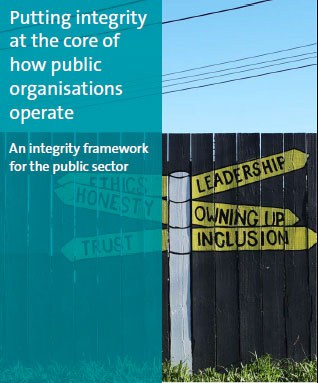A code of conduct
Why it matters: Builds a shared understanding of expected behaviours and fosters responsibility and accountability
A code of conduct is a powerful declaration of how every person in an organisation is expected to behave. It expands on organisational values to explain "the way we work around here". A code is like a moral compass that sets the standards of acceptable and unacceptable conduct for everyone who works at the organisation.
Introducing our new code of conduct took a lot of work but it has perhaps been the biggest contributor to the improvement in setting out the expectations of behaviour for all staff.”
Non-public service department integrity specialist
Research suggests that a code of conduct is positively correlated with preventing losses from wrongdoing.34 However, having a document does not prevent unacceptable conduct. The expectations it contains need to be demonstrated in the everyday behaviour of staff – and when they are not, staff need to be held to account.
Making ethical decisions is complex. It is fraught with contextual pressures and complications. An organisation's code of conduct assists staff by providing standards they can apply to specific situations.
What it looks like: A translation of the values into behaviours
A code of conduct defines how all staff should act, day to day. It should contain clear expectations that reflect an organisation's daily operations, core values, and culture. These expectations can be expanded on, either in the code or in accompanying guidance that provides additional support to staff, including clear guidance on the consequences for breaches and possible sanctions.
If staff members face an integrity problem, the code should help them exercise their own judgement, taking into consideration the individual circumstances of the situation, and arrive at a well-founded decision.
When preparing or updating a code of conduct, making the process inclusive and consulting with staff, staff networks, and unions will improve its effectiveness.35 However, publishing a code will not be enough on its own to influence behaviour and ethical decision-making. A code needs to be supported. This includes making avenues available to staff to raise specific questions or ethical dilemmas, a programme of communication and training, and leadership exhibiting the core values and desired behaviours.
The Public Service Commissioner has issued a code of conduct and accompanying guidance for public service organisations. The code applies to all public service organisations, but any organisation could incorporate it into its own code or produce supplementary codes to cover specific circumstances. Local authorities (councils) are legally required to adopt a code of conduct for their elected members.36
 |
It's worth considering...
|
34: Association of Fraud Examiners (2020), Report to the Nations: Global study on occupational fraud and abuse (see legacy.acfe.com).
35: There may also be situations where it is appropriate to consult with other external parties where there are important relationships, recognising that the expected behaviour of staff affects how integrity is demonstrated and seen from the outside.
36: Local Government Act 2002.


